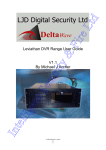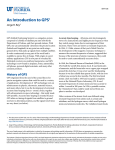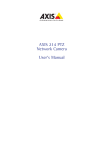Download Manual - I-Cube
Transcript
1 LANE LPR Install and user Manual 2011 MOBILE LPR User Manual page 2 Table of Contents 1. PURPOSE & SCOPE ............................................................................... 3 2. REFERENCED DOCUMENTS ................................................................. 3 3. OVERVIEW .............................................................................................. 3 3.1. Product description ............................................................................................................. 3 3.2. Typical installation .............................................................................................................. 4 3.3. Parking / Analogue versus Free flow / IP .......................................................................... 5 3.4. System Architecture ............................................................................................................ 6 3.4.1. System Components and interface .................................................................................... 6 3.4.2. Database ........................................................................................................................... 7 3.5. SOFTWARE ........................................................................................................................ 8 3.5.1. Software ............................................................................................................................ 8 3.5.2. Image Test ...................................................................................................................... 11 3.5.3. Alerts .............................................................................................................................. 12 3.5.4. Software Log .................................................................................................................. 13 3.5.5. FILTER........................................................................................................................... 13 3.5.6. Software Configuration .................................................................................................. 14 3.5.7. Image Actual Size ........................................................................................................... 15 MOBILE LPR User Manual page 3 1.Purpose & Scope This document provides operator, install and technical information on the 1 LANE PARKING ACCESS CONTROL LPR SYSTEM, a stand-alone vehicle identification system, logging and access control and alarm system. This document is intended for system users and owners and provides the information required operate the system. 2.Referenced Documents 2.1 MOBILE LPR Installation and Maintenance (for system installers) 2.2 Protocol for update data base files 2.3 Windows-based License plate recognition system (Technical information) 3.Overview 3.1.Product description 2 LANE LPR is a stand-alone vision-based logging and/or access-control system for vehicles. It identifies the license plate and automatically opens the boom or gate if the vehicle is in the database. There is an option to generate an alarm for vehicles listed in the database. All vehicles detected are recorded and logged. This revolutionary low cost LPR system is a highly integrated system based on a card that performs all the functions of a License Plate Recognition (LPR) system when linked to an analogue (CCTV) camera. The unit is easily installed in a PC, and requires a PCI slot. It automatically captures the image of the vehicle, locates the license plate, recognizes the registration number, compares it to the allowed or wanted list, and opens the gate or generates an alarm if in the list. All software is included (operates on XP or Windows 7 32bit) Vehicle numbers to open the gate or generate an alarm are stored on the unit’s local database. Users can change the wanted list using the Internet, a flash drive, USB stick or via an external computer. LPR can also transmit the recognized registration number though RS232 serial line or TCP/IP to a printer or display and also as an input to other systems (please request further system design information). This unit is a breakthrough in the LPR market which simplifies the architecture, cost and installation requirements over existing solutions. The 1 lane LPR unit is more compact and easier to install and use. The boom is open via a network based IO device (not included in the card) which can be used for finger prints, PIN codes and messages. MOBILE LPR User Manual page 4 3.2.Typical installation The following figure illustrates how the system is typically installed within a PC. Both MOBILE and FIXED systems are supported. A sensor (such as a loop detector) is not required to indicate the presence of the car. The LPR SOFTWARE automatically identifies the car and if wanted an alarm is generated. Figure 3.2: a typical installation For most access control / logging systems the system might control a single lane only, while the ability to perform both lanes is a huge advantage. Thus the system can perform both a single lane and two lanes (in the same or different directions). Please check the number of inputs on your card (from 1 or 2). MOBILE LPR User Manual page 5 3.3. Parking / Analogue versus Free flow / IP Our product line also includes a powerful free flow / IP solution. If an IP or multiple-lane (more than 2 lanes) is required, we recommend to install the FREE FLOW or IP LPR solution instead of the parking or analogue card which controls more lanes and has additional functions. Please consult with us on the optimum solution for your needs. MOBILE LPR User Manual page 6 3.4.System Architecture 3.4.1.System Components and interface The system architecture is illustrated in the following diagram. The peripherals on the left side are connected via communication modules / ports and can be connected if required. On the right side the inputs are power supply (a DC adapter connected to the battery). The output is the gate relay. MOBILE LPR User Manual \\\\\\\\ Output devices page 7 Camera (1-4) & PC LPR unit 3G / GSM 9-32V Communication Power Supply Wireless Wide range Cameras Bluetooth Terminal Remote Access via cellular phone or Internet Gate Figure 3.4: System architecture 3.4.2.Database The MOBILE LPR unit stores all license plates captured. An unlimited number of plates can be added and stored. The database is updated using one of the interfaces (as described above and detailed in the following sections). The database contains the registration number (e.g., "ABC123") and optional owner details (first and last name, e.g., "Bill Smith"). MOBILE LPR User Manual page 8 3.5.SOFTWARE 3.5.1.Software Install the following FOR ALL SYSTEMS: While not all the aspects of the software installed will be required or used, each install MUST consist of all install aspects to ensure all files, databases and software are copied and installed onto the PC. On the DVD UNDER SOFTWARE UNDER CARMEN INSTALL FREE FLOW THEN REBOOT On the DVD UNDER SOFTWARE UNDER CARMEN INSTALL PARKING THEN REBOOT On the DVD UNDER SOFTWARE INSTALL THEN SABREINSTALL.EXE REBOOT On the DVD UNDER PARKING COPY ALL THE FILES LISTED TO YOUR C DRIVE IN A FOLDER CALLED C:\PARKING MOBILE LPR User Manual Create the following short cuts to the PARKING FOLDER: LPR.EXE LPRManagement.exe WarranrtDataManagement.exe page 9 MOBILE LPR User Manual page 10 MOBILE LPR User Manual 3.5.2.Image Test page 11 MOBILE LPR User Manual 3.5.3. Alerts page 12 MOBILE LPR User Manual 3.5.4.Software Log 3.5.5. FILTER page 13 MOBILE LPR User Manual 3.5.6.Software Configuration page 14 MOBILE LPR User Manual 3.5.7.Image Actual Size page 15 MOBILE LPR User Manual - page 16 MOBILE LPR User Manual page 17 The Parking ANPR Software Engine The Parking License Plate Recognition Engine possesses all the features a high quality parking, security or access control license plate recognition system may require: it is highly accurate, fail safe, stable, fast and intelligent. The Parking system is specially designed for parking systems, security systems and access control systems. It has a unique integration level of the core license plate recognition technology, the video acquisition technology and the processing of multiple images of video streams, while in the same time it still offers the highest technological flexibility for you. Meanwhile it provides superior technological performance amongst today's car park license plate readers, Parking offers vast flexibility – favoured by speed cops and estates. Parking comes with an industrial quality native driver for image acquisition and video streaming, providing a plag-and-play core number plate recognition module (software and capture card) for car park and vehicle access control systems. There is no compromise. CARMEN® Parking's Software Development Kit (SDK) makesintegration plug-and-play: easy, fast and cost effective. Parking systems, access control systems, LPR security systems powered by CARMEN® deliver high recognition accuracy with a failsafe, high speed operation. Features of Parking Nowadays, parking lots are becoming an organic par of our everyday life. Parking offers flexible, low maintenance, yet effective and intelligent technology for car park operation. It reduces costs as well as increasing efficiency and security. Parking is a core technology rather than a complete application, as it was specially designed and developed to be easily integrated into complex parking and access control applications. As a flexible system it can be tailored to meet special customer requirements. The Parking ANPR package contains the following elements: ˇ Automatic number plate recognition engine ˇ FXVD4mc_s grabber card Test applications High Resolution Ultra Low Lux B/W Camera equipped with a special and synchronised IR flash. To achieve the best image and avoid any compatibility difficulties, Parking is delivered with a proprietary FXVD4mc_s video capture car. The system can be used on any existing PC system running in Windows Nt 4.0 or Windows 2000, Windows XP, Windows 2003. The ability to recognize registration number is a significant added value for comprehensive parking solutions or inventory management. A parking lot equipped with Carmen Parking can provide: ˇ Flexible and automatic vehicle entry to and exit from a car park ˇ Management information about car park usage ˇ Improved security for both car park operators and car park users ˇ Improved traffic flow during peak periods Other possible applications include: ˇ Vehicle recognition through date and time stamping as well as exact location ˇ Comprehensive database of traffic movement can be managed Technical Specifications of the Parking ANPR Engine Supported Operating Systems Windows 7 32bit, XP, 2003, 2000 Type of Plates Recognition is country and font independent. Any Latin, Arabic, Chinese, Korean and Cyrillic characters can be recognized. State/country region recognition (optional) Image Input Live video input through FXVD4 frame grabber card Trigger Trigger is needed for starting the recognition Sample Processing Time 50ms @ CPU 2GHz, 768x288 pixels (PAL/2) 3 seconds delay between two recognition processes on the same channel Processing Time Dependence Image quality (complexity, noise level etc.) Image size Processing power (CPU speed) Parameter settings MOBILE LPR User Manual page 18 Output Plate number in ASCII/UNICODE Position of plate Positions of characters Tip list for each characters Confidence levels for each tips Colour of plate (optional) Country ID (optional) Locating more plates on one image Documentation Reference Manual in electronic format System Requirements Intel PIII 1 GHz or higher CPU (128MB RAM) Free PCI / PC104+ slot For server applications or embedded systems/smart cameras we recommend CARMEN FreeFlow to use Applications of Parking Parking is specially designed for parking systems and access control systems. In LPR parking systems and LPR access control systems vehicles stop at the point of automatic vehicle identification (or slow significantly down). Also, most of the parking systems and access control systems are using standard CCTV video systems, and compatible hardware components. Consequently the main applications of Parking are the following: car park management, car parking automation, occupation management, automation of access control, security access control, flotilla management (car pool management), automation of vehicle entry to and exit from car parks, inventory management, state border control, etc... Systems using Parking: security vehicle plate readers, LPR parking systems, access control number plate readers, location manager vehicle license plate readers and automatic vehicle registration systems. Support and more Information You can contact us for more information and assistance at: Additionally, contact your local distributor for assistance and more information.























![[MANUAL] GuardNVR Installation Manual 4.4.0.0](http://vs1.manualzilla.com/store/data/005799040_1-22ffd5d438f0b0c95843f8ff9431bc2d-150x150.png)
